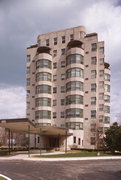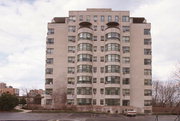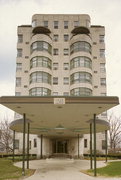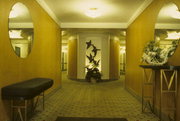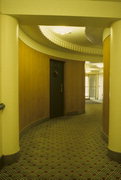| Additional Information: | A 'site file' exists for this property. It contains additional information such as correspondence, newspaper clippings, or historical information. It is a public record and may be viewed in person at the Wisconsin Historical Society, State Historic Preservation Office.
Locally designated: 7/12/1983. The car ports on the site were added at a later date.
When the owners of this chic apartment building promised tenants an ultramodern lifestyle, they kept their word. The Exton's design drew on the latest in technological and architectural thinking about comfort, convenience, and efficient use of space. Built toward the end of the Great Depression, the Exton also prefigured the many high-rise apartment buildings that would sprout along Prospect Avenue after World War II.
The Exton's exterior is nothing short of striking, with its simple yet elegant sense of geometry and its almost complete lack of embellishment or historical allusion. Pairs of faceted, half-round glazed bays reach from the ground level almost to the roof, dominating each limestone-clad façade. Corner windows frame the composition. The stripped-down, streamlined exterior reflects the machine-made aesthetic of the Moderne style, of which Herbert Tullgren was a master. (The building's other modernistic exterior feature, a keyhole-shaped canopy reaching out to the driveway, was added in the 1960s.)
Tullgren's interior is even more masterful than the exterior. Each Exton apartment is actually a two-story townhouse, with a spacious living room, kitchen, powder room, and sunny, bay-windowed dining room on the first level; and with two bedrooms, a bathroom, and a small sunroom on the second level. Each apartment can be entered only on its first level, so the elevator stops only at every other floor. The plan thus eliminates the need for service corridors on even-numbered floors, maximizing the rentable space. Tullgren had pioneered this space-saving design innovation when he created the Viking Apartment building in 1930. He secured a patent for this "Tullgren plan" and won high praise from the leading architectural journals of the era.
The Exton also boasted state-of-the-art heating, ventilating, and air-conditioning technology. Air conditioning, in particular, was rare in residences in 1939, so this was another selling point for the sophisticated Exton. |
|---|
| Bibliographic References: | ZIMMERMAN, 87.
BUILT IN MILWAUKEE, LANDSCAPE RESEARCH, P. 63.
Milwaukee Journal Sentinel 3/9/1997.
Building Permit application.
Architectural Record, v. 86, pp. 28-33, November 1939.
Latus and Young, p. 30.
Buildings of Wisconsin manuscript. |
|---|

